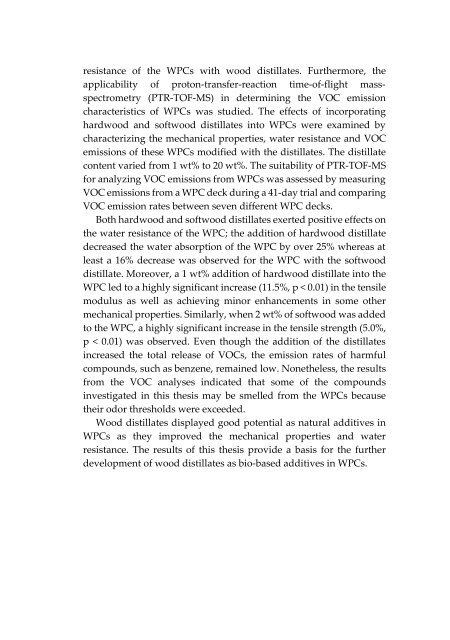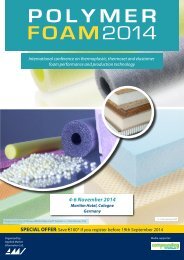Dissertations in Forestry and Natural Sciences
24lYKFN
24lYKFN
Create successful ePaper yourself
Turn your PDF publications into a flip-book with our unique Google optimized e-Paper software.
esistance of the WPCs with wood distillates. Furthermore, the<br />
applicability of proton-transfer-reaction time-of-flight massspectrometry<br />
(PTR-TOF-MS) <strong>in</strong> determ<strong>in</strong><strong>in</strong>g the VOC emission<br />
characteristics of WPCs was studied. The effects of <strong>in</strong>corporat<strong>in</strong>g<br />
hardwood <strong>and</strong> softwood distillates <strong>in</strong>to WPCs were exam<strong>in</strong>ed by<br />
characteriz<strong>in</strong>g the mechanical properties, water resistance <strong>and</strong> VOC<br />
emissions of these WPCs modified with the distillates. The distillate<br />
content varied from 1 wt% to 20 wt%. The suitability of PTR-TOF-MS<br />
for analyz<strong>in</strong>g VOC emissions from WPCs was assessed by measur<strong>in</strong>g<br />
VOC emissions from a WPC deck dur<strong>in</strong>g a 41-day trial <strong>and</strong> compar<strong>in</strong>g<br />
VOC emission rates between seven different WPC decks.<br />
Both hardwood <strong>and</strong> softwood distillates exerted positive effects on<br />
the water resistance of the WPC; the addition of hardwood distillate<br />
decreased the water absorption of the WPC by over 25% whereas at<br />
least a 16% decrease was observed for the WPC with the softwood<br />
distillate. Moreover, a 1 wt% addition of hardwood distillate <strong>in</strong>to the<br />
WPC led to a highly significant <strong>in</strong>crease (11.5%, p < 0.01) <strong>in</strong> the tensile<br />
modulus as well as achiev<strong>in</strong>g m<strong>in</strong>or enhancements <strong>in</strong> some other<br />
mechanical properties. Similarly, when 2 wt% of softwood was added<br />
to the WPC, a highly significant <strong>in</strong>crease <strong>in</strong> the tensile strength (5.0%,<br />
p < 0.01) was observed. Even though the addition of the distillates<br />
<strong>in</strong>creased the total release of VOCs, the emission rates of harmful<br />
compounds, such as benzene, rema<strong>in</strong>ed low. Nonetheless, the results<br />
from the VOC analyses <strong>in</strong>dicated that some of the compounds<br />
<strong>in</strong>vestigated <strong>in</strong> this thesis may be smelled from the WPCs because<br />
their odor thresholds were exceeded.<br />
Wood distillates displayed good potential as natural additives <strong>in</strong><br />
WPCs as they improved the mechanical properties <strong>and</strong> water<br />
resistance. The results of this thesis provide a basis for the further<br />
development of wood distillates as bio-based additives <strong>in</strong> WPCs.



